No matter the context, heroin addiction is an incredibly painful subject. The curse of heroin is that it is not a solitary drug. Everyone who comes into contact with this most potent opioid–from users to their loved ones–is affected in some tangible way. For many, the pain of addiction is translated into shame: shame for the dignity of the user, shame for the family, and shame that the potential to lead a life of actualization is tarnished by the overpowering nature of the drug. The lingering sense of pain and regret never ceases, even with the passage of time.
As one of the most prolific creators of YA graphic novels and picture books for young readers on the scene today, Jarrett J. Kroscoczka’s work is bright, colorful, and filled with wit. But his most powerful work to date is the complete opposite of his previous vivid and lively work. HEY, KIDDO (Graphix), released today, is a stark, mature, and heartrending tale of the author’s early life and his mother’s constant struggle to stay clean off of heroin; it’s often a losing battle. Raised by his grandparents as his mother cycles in and out of jail, young Jarrett is a boy whose sense of the world is colored by the melancholia of living without his mother for long stretches of time. What propels young Jarrett forward is art and HEY, KIDDO is as much about the development of an artist as it is about a young man trying to make his sense of the world. Recently, I sat down with Jarrett to discuss the long gestational period of the comic, what it was like writing a more mature-themed book for a young audience publisher, and the message he has for kids and families experiencing the effects of heroin addiction today.
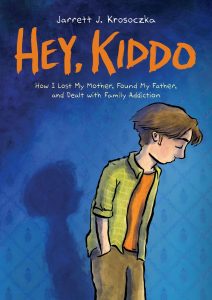
AJ FROST: Hi Jarrett. Thank you for taking the time to talk with me today. I’m not going to lie, as a reader, Hey, Kiddo crushed me. There’s so much emotional trauma, family memory, growth, pain, and catharsis… and that’s all in one chapter! As a writer, besides telling the best story you can, what was your mindset as you set your memories to paper? What did you seek to accomplish? And did you achieve your vision?
JARRETT J. KROSOCZKA: Thank you for saying so. I really didn’t want to hold anything back as I set this story down in words and pictures. What I learned early on was that there is a difference between organizing memories and writing a story with memories. There were some pieces that just didn’t make it into the book. Some because of space, some because they didn’t fit the through-line of the book. Perhaps those moments will be given to pieces of fiction or perhaps they will be strung together for future personal narratives.
What I really wanted to achieve with this book was to make readers feel that they were right there with me—throughout all the good and difficult moments. I wanted to humanize my mother, a heroin addict, and I wanted to create a space where readers might feel less alone, should they be living with family addiction. The fact that you are feeling crushed, I hope in the best way possible, I think I may have achieved my goal. But when I recently heard from a teen reader who saw themselves in this book, I knew I achieved something. Because now, this book has reached at least one young person who needed a book like this.
FROST: Can you walk me through the timeline of the development of this book? As I understand it, you conceived it in your early twenties, but held off on creating it until much later. How did the intervening years alter the approach you took with your memoir? And what did you learn along the way?

KROSOCZKA: Yes, back in 2000, I was executing the art for what would be my first published book. In my mind, that was the happy ending for this kid who always loved to draw but was surrounded by chaos. But every time I sat down to write the book, I would top and wonder what people would think—both the people in the book and the people who were getting to know me for my light-hearted picture books. As the years went on, I kept drawing my grandparents and teenage me in the margins of my sketchbooks. And as I was plotting out the Lunch Lady graphic novels, my mind kept getting pulled back to this graphic memoir. How did I get the courage to write this? Well, I gave an “accidental” TED Talk. I was a last-minute replacement for a headliner at TEDxHampshireCollege in 2012. With only four hours to get a talk together and make myself look presentable, my wife, Gina, encouraged me to talk about my childhood and to do so transparently.
That TED Talk went viral, and as I traveled the country for book tours over the years, I quickly learned that I was so far from alone as people, both kids and adults, connected with my story. I switched from wanting to write this book to needing to for these young readers.
FROST: While your oeuvre before Hey, Kiddo was friendly towards younger reader, this is a definitely mature work aimed at an older audience. Was there any tweaking you had to do internally to adjust to this new tone? Or were you so comfortable with the themes and proceeded as your heart told you to go?
KROSOCZKA: Well, there were many times that I would stop and start because of that. For instance, I couldn’t write about my family’s flaws and shortcomings without exploring my own. And I did fear that many aspects were in conflict with my image as a graphic novelist for the younger set. But I knew I had to put that reputation on the line to properly dive into my graphic memoir. My editor would point to Jack Gantos’s Hole in My Life. In Gantos’s memoir, he recounts the time he smuggled hashish over international borders on a boat and was later thrown in jail. So that became the barometer. Did you do anything worse than smuggling drugs over an international border? No? Then get it down on paper. And yes, Gantos is the celebrated children’s book author who visited my elementary school when I was a kid!
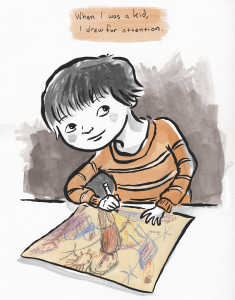
FROST: One of the more difficult aspects of the book, surely, is dealing with the dark nature of your family—the addiction, the alcoholism, the absenteeism—in a most public way. How did you navigate between being sensitive to your family’s feelings while also presenting the truth of your life? Did they approve of your openness? Was there pushback?
KROSOCZKA: Man, it was a tightrope walk for sure. When I was revising the script for the book, I attended a reading by David Sedaris. Afterwards, I bought a book in hopes of seeking advice from him. How do you write about real people? Mr. Sedaris told me that he doesn’t reveal his family members’ individual secrets. And he added, “Here’s the thing—if you live your like you’re an asshole, you’re going to be written about like you’re an asshole.” That was a breakthrough moment. Family members in the book were given the script and early sketches to read. I wanted to offer them that respect and courtesy because my life story is intertwined with theirs in many moments. I also wanted to be corrected if I had any facts off. And while I had some misunderstandings of the specifics of my grandfather’s work, the emotional arc and the personalities were all spot on for people. And no, nobody had any pushback.
FROST: Hey, Kiddo utilizes a limited palette. What inspired you to approach the coloring from this muted and minimalistic perspective?
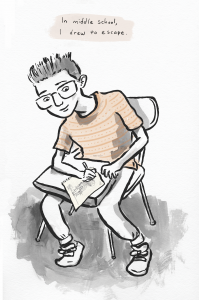
KROSOCZKA: I wanted this book to visually set itself apart from middle-grade graphic novels. Graphic memoir has a very large presence in the publishing industry, and I knew that people would assume that this was also middle grade. I also wanted to pay homage to my grandfather’s burnt-orange pocket square and I wanted the greyscales to be symbolic of my epiphany that life and people cannot be measured in black and white, rather varying shades of grey.
FROST: While this isn’t your first book with Scholastic, were you surprised at all that this would be the type of book that Scholastic would publish? It seemed to me to go against type, which only made it more emotionally resonant. Were there any concerns that some of the material and topics might be too much for young readers? How did you overcome any concerns (if there were any)?
KROSOCZKA: Scholastic Graphix did not push back on any of the language or content. They are bravely and confidently putting Hey, Kiddo out into the world. It hit me at their party at the 2018 San Diego Comic-Con. They had a fun photo booth, brightly-colored marketing materials with characters from their books, and book covers projected on an adjacent building. Hey, Kiddo is so very different for them, and I am so thrilled that they are publishing it. Scholastic Graphix revolutionized the comics industry when they started putting out books for young reads inn 2005. And now, they are taking another leap of faith with my young adult comic.
FROST: Ultimately, what do you want readers to understand as they finish this book, either about addiction, or family, or the potential of art to change lives?
I hope that readers learn just how complicated addiction is and how it can destroy a family. I hope that readers know that while my childhood was difficult, and I was raised by complicated people, I was loved. And above all, a child needs to know that they are loved and that adults have faith in them. Art gave me an identity and art offered me an escape. So, I hope that kids are given more space to create. Also, there are still plenty of caretakers and educators who look down on graphic novels and don’t consider it “real reading.” Perhaps Hey, Kiddo can win a few of them over.
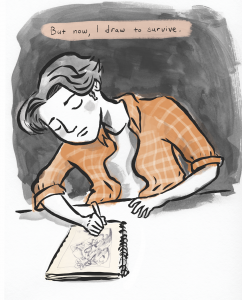
Hey, Kiddo is available in stores now.


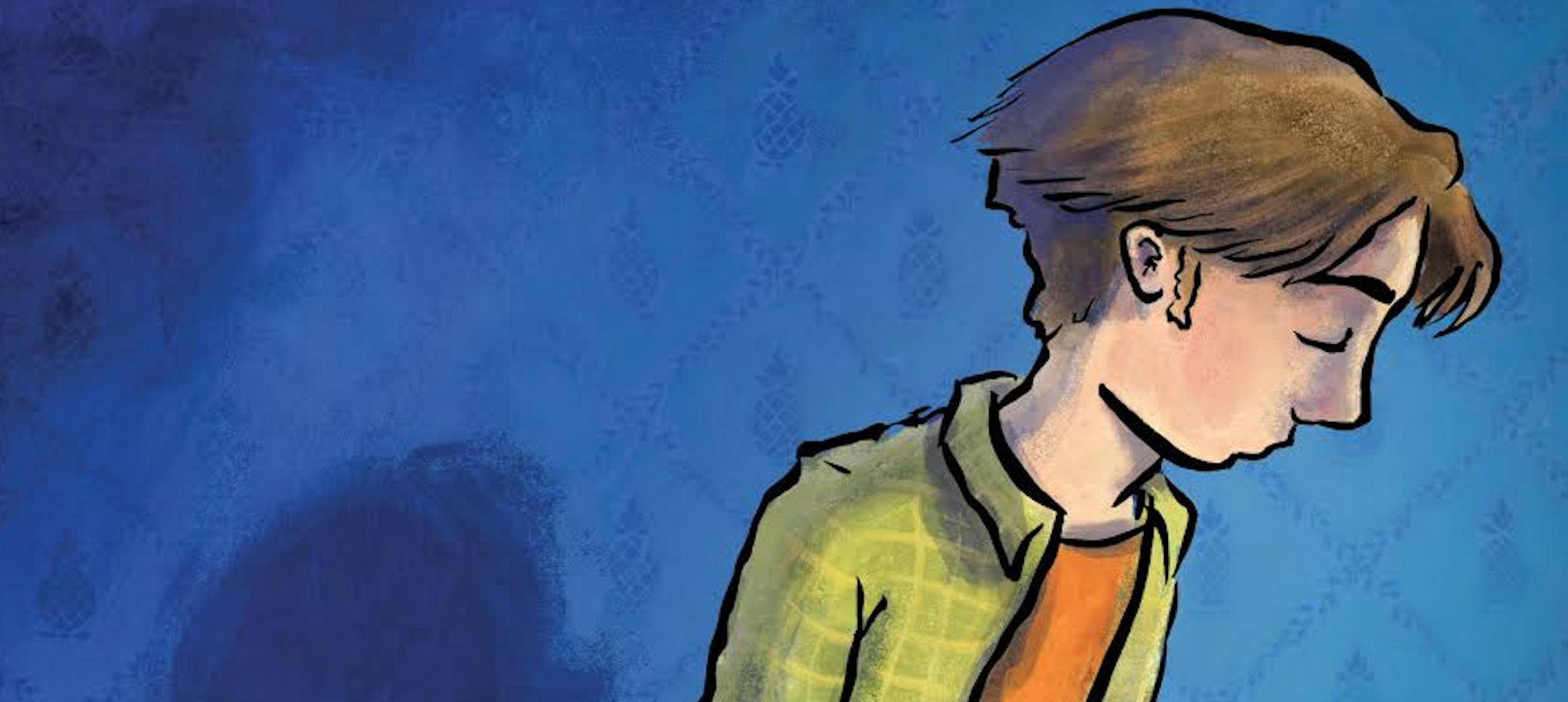






Cool interview.
Thanks Kaleb! Appreciate your kind words.
Comments are closed.